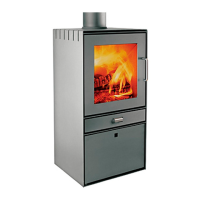to the right) for a few minutes at lighting. Put about 10 kindling sticks (dia.
2-3 cm) in the bottom of the stove, laid in a criss-cross pattern as a log
house. Put 2 firelighters in the middle and light them.
2. Leave the door ajar so there is an opening of about 2-3 cm. Leave the stove
like that for about 8-10 minutes before you close the door completely. Stay
by the stove as long as the door is ajar. Make sure the damper on the right
side of the stove is pulled out (open)
3. When the fire has burned to embers (there are no more flames) open the
door gently so the ash is not whirled out through the door. Gently spread out
the embers with a poker so they are even.
4. Put 2-3 pieces of firewood in the stove, about 1.7 kg total. The pieces are
put in the bottom of the stove and parallel to the front of the stove with
equal distance to the stove’s sides and with mutual distance of about 1 cm.
The front piece is best lit if it has a split side that is turned to the door and
one in the embers. Close the door completely immediately.
5. The knob/damper on the right side of the stove, is opened so it is about 2/3
open (pulled out) and after about 2 minutes the damper is set to about 1/3
open. How much the damper should be open depends on the individual
chimney’s draught, but the flames should now stabilise to a calm fire.
6. When the wood has burned to embers (after about 1 hour) you start again
from point 3.
3. MAINTENANCE – always use original parts
Maintenance and cleaning of the stove should only be performed when the
stove is cold.
The daily maintenance is limited, but once a year the stove should get
thorough maintenance. The combustion chamber should be cleaned for ashes
and soot and the door hinges and the closing mechanism should be lubricated
with copper grease.
The surface is maintained by brushing it with a soft, long-haired brush or by
using the vacuum cleaner with a brush. The stove can also be dusted with a
duster. Always remember: only when the stove is cold.
Jointings can look okay, but they collapse under the heat and thereby lose the
ability to keep the stove sealed. Jointings should be changed as needed as it is
important to good combustion and a clean window that the stove is sealed.
The insulation plates in the combustion chamber that are broken or worn
can easily be changed as they are loosely fixed. The material used is called
Vermiculite and is a porous, but very suitable insulation material. It has no

